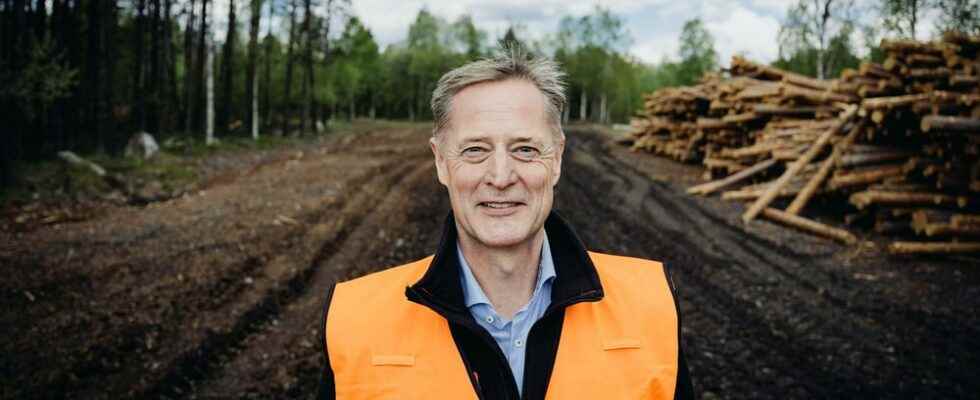It sticks in the nose of the raw wood smell inside the company Setra’s sawmill in Malå, Västerbotten. Erik Brandsma moves accustomed among saws and conveyor belts. This is not the first time he has visited a sawmill, and it will definitely not be his last, now that he has shouldered the role of Sveaskog’s new CEO.
Erik Brandsma grew up in the forest-poor Netherlands, and still chose to study forestry engineering. He succeeds Sveaskog’s former CEO Hannele Arvonen, who in January 2021 was allowed to leave his post with immediate effect.
The company then wrote that “The strategic direction Sveaskog has adopted will place demands on clear and comprehensive development and change work, which is why the board has decided to implement a change of leadership”.
– I got the question from a recruitment company and became very interested, he says and continues:
– The forest in Sweden is very special, it affects very many and is a strong foundation in Swedish society. It is a very exciting job to have.
Statliga Sveaskog, which is Sweden’s largest forest owner, has previously been heavily criticized for its way of felling, which creates large clear-cuts.
– I know that there are pictures and stories about giant clear-cutting, but that time is over, says Erik Brandsma and adds:
– Most clear-cuts we have are up to 10 hectares. I agree that we can adapt the fellings so that they fit better into the landscape. But we must not stop cultivating the forest. However, it does not have to be clear-cut everywhere and definitely not large ones.
The company’s high felling targets have also been the subject of criticism. The goals have been considered to take precedence over everything else and not sustainable for either the owners’ economy, reindeer husbandry or biodiversity. Now the CEO opens to reduce the felling target.
– I think we have had a lot of focus on felling levels that have been quite high for a long period, says Erik Brandsma and continues:
– We need to evaluate what it costs us and means for others who have interests in the forest. We need to look at the levels with new eyes and try to find a balance between different interests. To achieve a balance, we may need to reduce our felling level, but we will only do so for a short period. With the growth of the forest, we will in the long term be able to increase volumes again.
Some who have been hit hard by Sveaskog’s fellings are the Sami. Previously, the company has stated that it takes dialogue with the Sami very seriously. At the same time, the Swedish Sami National Federation, SSR, has described to DN that “Sveaskog is the worst in the class”, and felling without regard to the Sami or the environment.
– I do not agree with that, says Erik Brandsma and continues:
– But I agree that we sent signals to the Sami villages without living up to expectations. That is my big challenge. We have a good dialogue with quite a few Sami villages, then we have locked dialogues with two. I have now met them and I understand why it has become a locked situation, where they come from and their history, says Erik Brandsma and adds:
– We have said that we will meet again, and take the next step. I interpret this as very positive and I am cautiously positive that we can move forward.
Sweden receives repeated criticism from the UN and the Council of Europe for not giving the Sami enough influence on issues that affect their traditional lands. But there, the new CEO is not prepared to give more influence.
Will the Sami have a greater influence now that you are CEO?
– The most important thing for me is that we have a good dialogue where we come to common conclusions.
In 2020, Sveaskog was awarded the less flattering prize for this year’s greenwashing by the environmental organization Friends of the Earth. The reason, according to Friends of the Earth, was Sveaskog’s big words about climate and environment, but a little workshop.
What can you do to prevent a lot of words and a little workshop?
– We need to seriously show that we can think new, develop and contribute to biodiversity and climate change. The only thing I can say is, give us a chance to show it, because it takes time.
Sveaskog
Sveaskog is Sweden’s largest forest owner and owns 14 percent of the forest land in the country, and is owned by the Swedish state.
In total, Sveaskog’s land amounts to 10 percent of Sweden’s total land area.
In 2021, Sveaskog had sales of just over SEK 7.5 billion.
The Riksdag decided in 2001 that Sveaskog would not own any forest industry. The Swedish National Audit Office also criticized Sveaskog’s ownership of one of Sweden’s largest sawmill companies, Setra. The authority considered that ownership made it difficult to be an independent player. Today, 20 years later, the company still owns half of Setra.
Show more
Erik Brandsma
Born 1964 in the Netherlands.
Is the new CEO of Sveaskog and will take up the position on 15 January 2022.
He is a trained forest engineer and has a master’s degree in natural resource management from British Columbia in Canada.
Brandsma has previously been head of sustainability for both Vattenfall AB and EON AG, but worked for the OECD and the UN Commission on Sustainable Development.
During the years 2012 to 2018, Erik Brandsma was Director General of the Swedish Energy Agency before he became CEO of Jämtkraft.
Show more
